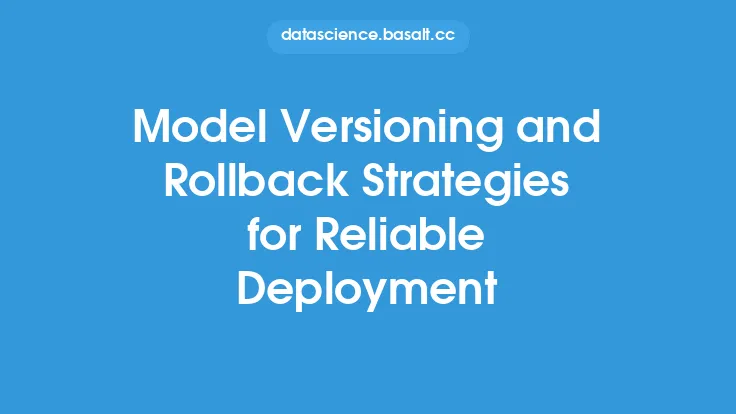Monitoring and logging are essential components of model deployment in machine learning. They provide valuable insights into the performance and behavior of deployed models, enabling data scientists and engineers to identify issues, optimize model performance, and ensure reliable operation. In this article, we will delve into the importance of monitoring and logging in model deployment, exploring the benefits, challenges, and best practices for implementing effective monitoring and logging strategies.
What is Monitoring in Model Deployment?
Monitoring in model deployment refers to the process of tracking and observing the performance of a deployed model in real-time. This involves collecting and analyzing metrics and data that indicate how well the model is performing, such as accuracy, precision, recall, and latency. Monitoring helps to identify issues, such as data drift, concept drift, or model degradation, which can impact the model's performance and accuracy. By monitoring the model's performance, data scientists and engineers can take corrective actions to address issues, update the model, or retrain it as needed.
What is Logging in Model Deployment?
Logging in model deployment refers to the process of recording and storing information about the model's behavior, including input data, output predictions, errors, and exceptions. Logging provides a detailed record of the model's activity, allowing data scientists and engineers to diagnose issues, debug problems, and analyze the model's behavior over time. Logging can also help to identify patterns, trends, and anomalies in the data, which can inform model updates, improvements, and optimization.
Benefits of Monitoring and Logging
Monitoring and logging offer several benefits in model deployment, including:
- Improved model performance: By tracking performance metrics, data scientists and engineers can identify areas for improvement and optimize the model for better accuracy and reliability.
- Faster issue detection and resolution: Monitoring and logging enable quick detection of issues, such as data quality problems or model degradation, allowing for prompt corrective actions.
- Enhanced model reliability: Monitoring and logging help to ensure that the model operates reliably and consistently, reducing the risk of errors, downtime, or data loss.
- Data-driven decision-making: Monitoring and logging provide valuable insights into the model's behavior, enabling data-driven decision-making and informed model updates.
- Compliance and auditing: Logging can help to demonstrate compliance with regulatory requirements, such as data privacy and security standards, and provide a record of model activity for auditing purposes.
Challenges in Monitoring and Logging
While monitoring and logging are essential in model deployment, there are several challenges to consider, including:
- Data volume and velocity: Large volumes of data can be generated by monitoring and logging, requiring efficient data processing, storage, and analysis capabilities.
- Data quality and noise: Poor data quality or noisy data can impact the accuracy and reliability of monitoring and logging, requiring data cleaning, preprocessing, and filtering techniques.
- Model complexity: Complex models, such as deep learning models, can be challenging to monitor and log, requiring specialized tools and techniques.
- Scalability and performance: Monitoring and logging can impact model performance, requiring optimized implementation to minimize latency and overhead.
Best Practices for Monitoring and Logging
To implement effective monitoring and logging strategies, consider the following best practices:
- Define clear metrics and KPIs: Establish relevant metrics and key performance indicators (KPIs) to track model performance and behavior.
- Use specialized monitoring and logging tools: Utilize tools, such as Prometheus, Grafana, or ELK Stack, designed for monitoring and logging in machine learning.
- Implement data quality checks: Ensure data quality by implementing data validation, cleaning, and preprocessing techniques.
- Optimize logging and monitoring for performance: Minimize the impact of logging and monitoring on model performance by optimizing implementation, using caching, or sampling data.
- Regularly review and analyze logs: Regularly review and analyze logs to identify issues, trends, and patterns, and inform model updates and improvements.
Technical Considerations
When implementing monitoring and logging in model deployment, consider the following technical aspects:
- Data storage and management: Design a data storage and management strategy to handle large volumes of log data, such as using distributed storage systems or cloud-based logging services.
- Data processing and analysis: Utilize data processing and analysis tools, such as Apache Spark or Apache Flink, to handle high-volume log data and perform real-time analytics.
- Model serving and deployment: Consider the impact of monitoring and logging on model serving and deployment, such as using containerization or serverless architectures to optimize performance.
- Security and access control: Ensure that logging and monitoring data are properly secured, with access controls and encryption, to protect sensitive information.
Conclusion
Monitoring and logging are critical components of model deployment in machine learning, providing valuable insights into model performance and behavior. By understanding the benefits, challenges, and best practices for monitoring and logging, data scientists and engineers can implement effective strategies to ensure reliable, accurate, and high-performing models. As machine learning continues to evolve, the importance of monitoring and logging will only grow, enabling organizations to unlock the full potential of their models and drive business success.





